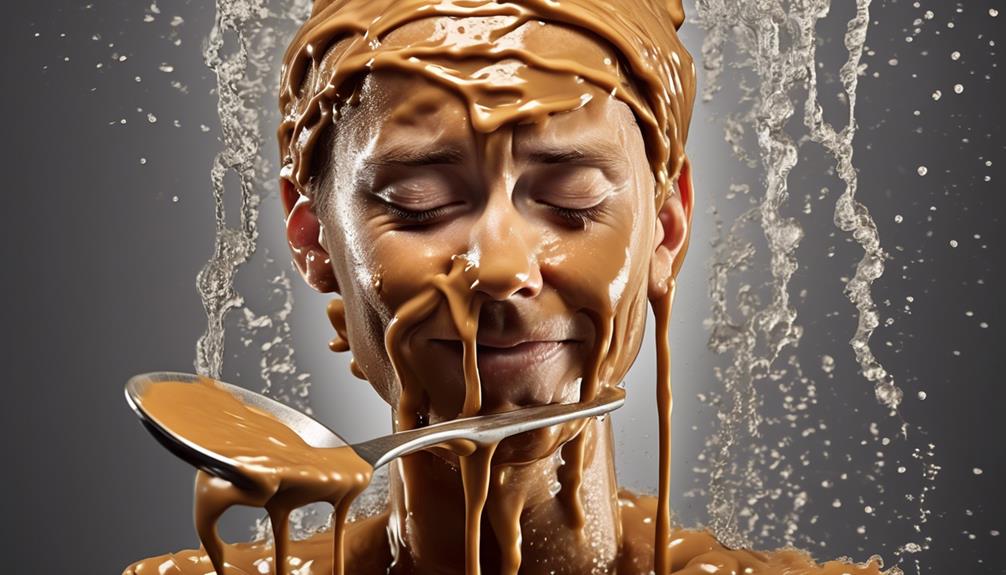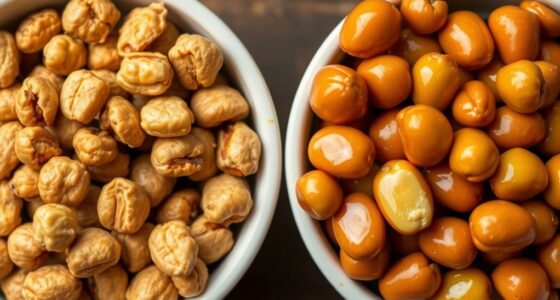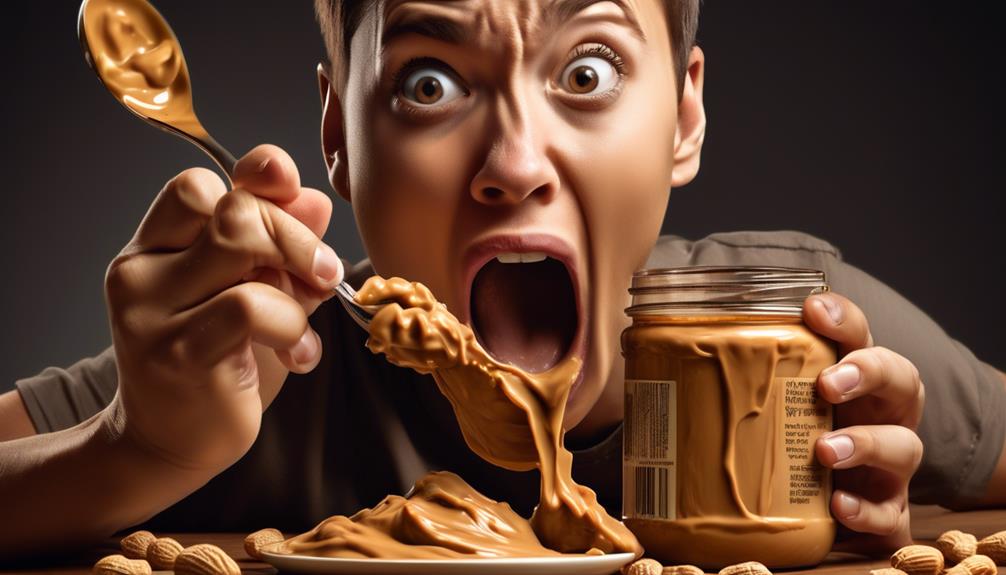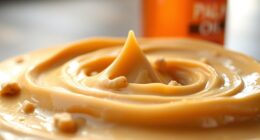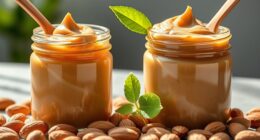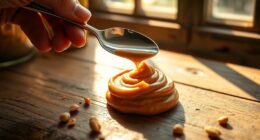Have you ever thought about the taste of roasted peanuts combined with a touch of sweetness? Peanut butter, a popular item found in many pantries, offers a distinct flavor that has led to discussions and favorite choices among food lovers.
Some prefer the smooth, creamy texture of classic peanut butter, while others crave the satisfying crunch of chunky varieties. But what exactly contributes to the distinct taste of peanut butter?
Join us as we delve into the complex layers of flavor, texture, and aroma that make peanut butter a beloved spread and ingredient in culinary creations.
Key Takeaways
- Peanut butter offers a blend of nuttiness, slight sweetness, and a hint of saltiness, providing a robust and pure nutty flavor.
- Peanut butter is versatile and can complement both sweet and savory dishes, adding depth and richness to recipes.
- Creamy peanut butter has a luxurious texture that spreads effortlessly and adds a delicate nuance of sweetness to its flavor profile.
- Peanut butter's savory undertones contribute to its rich and complex flavor, making it adaptable for a variety of culinary creations.
The Nutty Flavor Profile
Exploring the nutty flavor profile of peanut butter reveals its rich, earthy undertones and distinctive aroma, enticing the senses with its complex and satisfying taste.
The peanut flavor in peanut butter is unmistakable, offering a blend of nuttiness, slight sweetness, and a hint of saltiness. This unique combination creates a versatile taste that can complement both sweet and savory dishes.
In a Blind Taste Test, the natural peanut flavor of authentic, less processed peanut butter shines through, providing a robust and pure nuttiness that's both comforting and wholesome. On the other hand, the cream peanut butter, with its smoother texture and slightly sweeter taste, appeals to those who prefer a more indulgent experience.
The nutty essence of peanut butter not only adds depth and richness to recipes but also stands out as a delightful spread on its own. Whether enjoyed as a simple snack or incorporated into complex culinary creations, the nutty flavor profile of peanut butter offers a satisfying and enjoyable taste experience.
A Hint of Sweetness

When it comes to A Hint of Sweetness peanut butter, the combination of sweet and nutty flavors creates a delightful balance.
The creamy texture makes it easy to spread, while its versatility allows for a wide range of culinary uses.
With its balanced sweetness and high-quality ingredients, A Hint of Sweetness peanut butter offers a satisfying and versatile taste experience.
Sweet and Nutty
With a balanced blend of sweetness and nuttiness, the flavor profile of Sweet and Nutty (A Hint of Sweetness) offers a pleasing taste that enhances the overall nutty experience. This peanut butter variety provides a delightful combination of sweetness and nuttiness that appeals to the taste buds. The nuanced sweetness complements the natural nutty flavor, adding depth to the overall taste. Below is a comparison table of three popular peanut butter brands:
| Peanut Butter Brand | Texture | Taste |
|---|---|---|
| Jif Peanut Butter | Creamy | Rich and Slightly Sweet |
| Almond Butter | Smooth | Nutty with a Hint of Sweetness |
| Skippy Creamy | Silky | Balanced Sweetness and Nuttiness |
In the world of peanut butter, the Sweet and Nutty (A Hint of Sweetness) variety strikes a perfect balance, offering a nuanced sweetness that enhances the rich, nutty flavor.
Creamy Texture
The creamy texture of peanut butter, with its subtle hint of sweetness, offers a velvety smoothness that enhances the overall flavor and mouthfeel.
- The creamy consistency of peanut butter creates a luxurious sensation as it glides across the palate, imparting a rich and satisfying experience.
- This smooth texture allows for effortless spreading on various foods, from bread to fruits, making it a delightful addition to snacks and meals.
- The touch of sweetness in creamy peanut butter adds a delicate nuance to its flavor profile, elevating its appeal to those seeking a harmonious blend of taste and texture.
The creamy texture of peanut butter is a key element in understanding and appreciating its delectable qualities, making it a beloved staple in many households.
Versatile Flavor
As we explore the concept of versatile flavor in peanut butter, it becomes evident that its creamy texture, with a subtle hint of sweetness, sets the stage for a unique and adaptable taste experience.
The balanced taste of peanut butter, incorporating a gentle sweetness alongside its nutty essence, makes it a versatile ingredient suitable for both sweet and savory dishes. This adaptability allows peanut butter to add depth and richness to recipes, enhancing the flavor profile of a wide range of foods.
Its versatile flavor profile complements not only sweet treats and desserts but also savory dishes, sauces, and sandwiches. The slight sweetness in peanut butter makes it a popular choice for both cooking and snacking, offering a pleasant and adaptable flavor profile that appeals to a diverse array of palates.
Creamy and Smooth Texture

The creamy and smooth texture of peanut butter plays a significant role in enhancing its overall appeal. It provides a velvety consistency that spreads effortlessly and evenly on various surfaces, from bread to crackers.
This texture also contributes to the satisfying mouthfeel and adaptability of peanut butter in both sweet and savory recipes.
Rich Nutty Flavor
Occasionally, peanut butter exhibits a rich, nutty flavor accompanied by a creamy and smooth texture that enhances its overall palatability. This flavor profile is further complemented by the creamy and smooth texture that creates a satisfying mouthfeel. When it comes to the best peanut butters, the rich nutty flavor is reminiscent of freshly roasted peanuts, offering a delightful blend of savory and sweet notes. Its ability to taste like peanuts while delivering a balanced and satisfying experience makes it a beloved choice for many.
Peanut butter becomes a versatile ingredient that can be enjoyed in various ways. It can be used as a delicious spread for sandwiches, adding a layer of richness and flavor to the bread. It can also be incorporated into recipes to add depth to sauces and dressings. The creamy and smooth texture of peanut butter allows it to blend seamlessly with other ingredients, enhancing the overall taste of the dish.
In addition to its taste and texture, peanut butter is also a nutritious choice. It is a good source of protein and healthy fats, making it a satisfying option that can help keep you full and satisfied. It also contains vitamins and minerals such as vitamin E, magnesium, and potassium.
Versatile Ingredient
Transitioning from the discussion of the rich nutty flavor, we now explore the role of peanut butter as a versatile ingredient with its creamy and smooth texture.
Its spreadable nature makes it a convenient addition to a wide range of recipes. Whether it's spreading it on bread, adding it to smoothies, or using it as a base for sauces and dips, the creamy and smooth texture of peanut butter enhances both sweet and savory dishes, making it a versatile ingredient in your pantry.
In baking, its smooth texture helps create moist and flavorful treats like cookies, brownies, and cakes.
Additionally, its creamy consistency is perfect for blending into soups, adding a touch of richness and enhancing the overall flavor.
Peanut butter's creamy and smooth texture truly makes it a versatile and indispensable ingredient in the kitchen.
Mouthfeel and Consistency

When experiencing peanut butter, the mouthfeel and consistency play a significant role in shaping the overall sensory experience, offering a wide range of textures to cater to diverse preferences.
- Creamy Varieties:
Creamy peanut butter offers a silky, spreadable consistency that's perfect for sandwiches, baking, or adding to smoothies. The smooth texture enhances its versatility as a spread and an ingredient in various recipes.
- Chunky Varieties:
Chunky peanut butter provides a more textured mouthfeel, with visible pieces of peanuts offering a satisfying crunch and enhancing the overall eating experience. The added crunchiness adds a delightful element to the traditional smoothness of peanut butter.
The mouthfeel and consistency of peanut butter can greatly impact its usability in different recipes, making it essential to choose the right texture for specific culinary applications. Whether it's for spreading on toast, mixing into sauces, or simply enjoying it by the spoonful, the diverse textures of peanut butter cater to various preferences and culinary needs.
Whether you prefer the silky smoothness of creamy peanut butter or the satisfying crunch of chunky varieties, there's a peanut butter texture to suit every palate and recipe.
The Roasted Peanut Aroma

The diverse textures of peanut butter, catering to various preferences and culinary needs, lead us to explore the rich and inviting aroma of roasted peanuts.
The roasted peanut aroma has a warm, nutty scent with hints of sweetness and a slightly toasty quality. It evokes a sense of comfort and nostalgia, reminiscent of freshly roasted peanuts enjoyed at fairs and festivals. The aroma carries a rich, earthy note, accompanied by a subtle caramel-like sweetness, creating a well-balanced and inviting fragrance. Additionally, it has a distinct, savory undertone, reminiscent of the familiar and satisfying flavor of roasted peanuts.
This aroma is robust and full-bodied, with a depth that captures the essence of freshly roasted peanuts, making it a delightful sensory experience. When experienced, it brings to mind images of golden-brown peanuts being roasted to perfection, and the resulting aroma is both familiar and comforting.
The roasted peanut aroma plays a significant role in shaping the overall sensory experience of consuming peanut butter, adding depth and richness to its flavor profile.
Savory Undertones

With a balanced contrast to its natural sweetness, peanut butter's savory undertones contribute to its rich and complex flavor profile. When exploring the savory undertones of peanut butter, it's important to consider how they enhance the overall taste experience, especially when combined with other flavors.
- The savory undertones in peanut butter provide depth and complexity, making it a versatile ingredient for both sweet and savory dishes.
- When paired with jelly, the savory undertones of peanut butter create a harmonious balance, elevating the classic Peanut Butter and Jelly sandwich to a new level of flavor.
- The subtle savory undertones in peanut butter complement umami-rich flavors, adding depth to dishes like curries and stir-fries.
- When used in savory recipes, peanut butter's savory undertones create a unique flavor profile that enhances the dish without overpowering other ingredients.
Tasting Notes: Saltiness

In peanut butter, the saltiness can significantly impact the overall flavor profile, influencing its complex and satisfying taste. The level of saltiness in peanut butter varies among different brands and types, with some exhibiting a more pronounced saltiness than others.
When balanced correctly, the saltiness adds a savory and slightly tangy dimension to the peanut butter, enhancing the natural nutty and sweet notes. This balanced saltiness creates a more complex and satisfying taste, complementing the inherent flavors of the peanuts.
However, excessive saltiness can overpower the taste of the peanuts, resulting in an unpleasant and overly salty flavor that detracts from the rich, nutty essence that peanut butter should offer. Therefore, paying attention to the saltiness can aid in selecting a peanut butter that aligns with personal taste preferences.
A well-balanced saltiness not only enhances the taste of peanuts but also contributes to the overall enjoyment of peanut butter, making it a versatile and delectable spread for various culinary creations.
The Lingering Aftertaste

Exploring the lingering aftertaste of peanut butter reveals a nuanced and integral aspect of its flavor profile.
- The lingering aftertaste of peanut butter is a distinctive taste that remains in your mouth after consuming it, leaving a lasting impression of its flavor.
- This aftertaste often tastes like peanuts, emphasizing the nuttiness of the spread and adding depth to the overall experience.
- It can vary in intensity and flavor, ranging from a subtle nuttiness to a slightly sweet and savory finish, enhancing the complexity of the peanut butter.
The lingering aftertaste of peanut butter adds a unique dimension to its flavor profile, making it more than just a simple spread. It complements both sweet and savory dishes, making it a versatile ingredient.
This aftertaste not only enhances the overall peanut butter experience but also distinguishes different brands and varieties based on the nuances of its lingering flavor. Whether enjoyed on its own or incorporated into various recipes, the lingering aftertaste of peanut butter remains a defining and memorable characteristic of this beloved spread.
Variations in Flavor Intensity

Variations in flavor intensity in peanut butter are influenced by factors such as the type of peanuts used, roasting levels, added ingredients, and texture.
The taste of peanuts can range from mild and earthy to robust and intense, depending on these variables. The type of peanuts, whether they're Valencia, Virginia, or Spanish, can impact the flavor profile.
Additionally, the level of roasting the peanuts undergo can greatly influence the intensity of the peanut flavor, with darker roasts often yielding a more intense, almost caramel-like taste.
Added ingredients, such as sugar, salt, or even honey, can contribute to a sweeter or saltier flavor profile, altering the overall intensity of the peanut taste.
Furthermore, the texture of the peanut butter, whether it's smooth and creamy or crunchy, can also impact the perception of flavor intensity. Creamier varieties may offer a more spread-out, lingering taste, while crunchier options may provide a more pronounced burst of peanuts.
Ultimately, the interplay of these factors contributes to the diverse range of flavor intensities found in different peanut butter products.
Nutritional Aspects to Consider

One might consider the nutritional aspects of peanut butter before incorporating it into their diet, as it contains a significant amount of healthy unsaturated fats and serves as a good source of protein. When evaluating the nutritional aspects of peanut butter, it's essential to take into account various factors:
- Caloric Content: Peanut butter is high in calories, with an average serving containing about 190 calories. This may be a factor to consider for individuals who are mindful of their calorie intake.
- Healthy Fats and Protein: Peanut butter provides a substantial amount of healthy unsaturated fats, which can be beneficial for heart health. Additionally, it serves as a good source of protein, offering about 8 grams per serving.
Considering these nutritional aspects is crucial, especially when some peanut butter brands may contain added sugar, hydrogenated oils, or palm oil, which can impact its nutritional value. Furthermore, it's important to be aware of potential allergens, as peanut butter is a common allergen and may not be suitable for individuals with peanut allergies. Therefore, understanding the nutritional components and added ingredients can aid in making informed decisions about incorporating peanut butter into one's diet.
Pairing Combinations and Tasting Suggestions

When it comes to exploring the taste of peanut butter, we can't overlook the significance of flavor pairings and tasting recommendations.
By understanding the art of combining peanut butter with sweet and savory ingredients, we can elevate the overall taste experience.
From classic PB&J sandwiches to innovative pairings with fruits and textures, the possibilities are endless for creating delightful taste sensations.
Flavor Pairings
To enhance the nutty and savory flavors of peanut butter, it can be expertly paired with a variety of complementary tastes, such as spicy and umami-rich flavors, offering a delightful balance of sweet and savory notes in a range of culinary creations. When considering flavor pairings with peanut butter, popular brands like Classic Peanut offer a rich and creamy base for experimentation.
Some great pairings include:
- Spicy: The heat from chili peppers or the warmth of ginger can complement the nuttiness of peanut butter, creating a complex and satisfying flavor profile. Try adding a dash of cayenne to peanut butter cookies for a surprising kick.
- Sweet: Peanut butter pairs wonderfully with the creamy sweetness of ice cream, creating a delightful combination of indulgent flavors. Drizzle warm peanut butter over vanilla ice cream for a simple yet luxurious dessert.
Tasting Recommendations
Exploring the intricate flavors of peanut butter in pairing combinations and tasting suggestions reveals a world of culinary possibilities, enhancing the nutty and savory notes with a diverse range of complementary tastes.
Pair Jif Creamy Peanut Butter with honey for a delightful blend of sweetness, or spread it on toast with sliced bananas for a comforting snack.
For a unique twist, consider incorporating peanut butter into homemade ice cream for a rich and creamy treat.
When it comes to tasting, try a blind test of different peanut butter brands to discern subtle variations in flavor profiles and ingredients, such as the presence of palm oil.
Whether in a savory stir-fry or a batch of freshly baked cookies, the versatility of peanut butter makes it a delightful addition to both sweet and savory dishes.
Evaluating Different Brands

Upon assessing different brands of peanut butter, it's essential to prioritize minimal and natural ingredients, avoiding added sugars and hydrogenated oils to ensure a balanced and satisfying flavor. When evaluating different brands of peanut butter, we consider various factors to determine the best option. Here are some key points to keep in mind:
- Consider the Ingredients:
- Look for options with minimal and natural ingredients, such as the Best Peanut brand, to ensure a pure and authentic peanut taste.
- Avoid products with added sugars and hydrogenated oils, as these can overpower the natural flavor and compromise the texture.
- Assess the Flavor and Texture:
- Pay attention to the balance of sweetness and nuttiness in the peanut butter, such as in the Peter Pan Creamy variety, to ensure an enjoyable taste experience.
- Evaluate the texture to determine if the peanut butter is smooth and creamy, without being overly oily or gritty, providing a pleasant mouthfeel.
Exploring Unique Peanut Butter Varieties

After assessing different brands of peanut butter based on ingredients, flavor, and texture, we can now explore unique varieties to further understand the diverse range of taste experiences available.
When it comes to unique peanut butter varieties, it's fascinating to see how different brands can offer such distinct flavor profiles. Some varieties may have a rough taste with a strange floral aftertaste, while others may taste vaguely of mothballs or have a rancid oil taste. Additionally, certain varieties may be too sweet and molasses-y, while some may even have a super sweet and bitter taste, almost like dirt.
Despite these less favorable characteristics, there are also standout options. Trader Joe's Peanut Butter, for example, is highly regarded for its great flavor, silky smooth texture, and ability to not separate when refrigerated. It presents a stark contrast to other varieties that may contain lots of peanut skins blended in, resulting in a salty punch and silky texture.
Through exploring these unique peanut butter varieties, we gain a deeper appreciation for the wide spectrum of taste experiences that can be derived from something as simple as peanuts.
Frequently Asked Questions
How Does a Peanut Butter Taste?
Peanut butter tastes like a delightful blend of nuttiness, subtle savoriness, and a hint of sweetness. Its versatility makes it a perfect addition to both sweet and savory dishes, complementing spicy and umami flavors.
The texture, whether smooth or crunchy, varies among fans. Preferences for the best tasting peanut butter differ, influenced by factors like texture, natural or processed, and sweetness.
How Do You Describe Peanut Butter?
Peanut butter, a delightful blend of savory and sweet, offers a rich, nutty taste with a smooth or crunchy texture. Its versatility allows for use in both sweet and savory dishes.
Symbolically, it represents comfort and nostalgia, evoking warm childhood memories. The flavor profile is a muddle of nuttiness and mild sweetness, making it a beloved and familiar taste.
How Would You Describe the Flavor of Peanut?
Peanut butter flavor is a complex combination of nuttiness, a touch of savory, and a hint of sweetness. It's versatile, fitting into both sweet and savory dishes, with a range of textures from smooth to chunky.
Described as a bit salty and sweet, personal preferences vary based on factors like texture and sweetness. Some enjoy the natural, less processed varieties, while others favor the creamier, sweeter options.
Is Peanut Butter Sweet or Sour?
Peanut butter is sweet, not sour. It has a rich, nutty flavor with a hint of sweetness. The taste may vary based on whether it's natural or processed, with natural peanut butter being less sweet.
It's a versatile condiment, used in both sweet and savory dishes. The texture can range from smooth and creamy to chunky with partial peanut bits.
Conclusion
In conclusion, peanut butter offers a unique combination of nutty, sweet, and savory flavors, with a creamy and smooth texture that can be enjoyed in a variety of dishes. Its versatility and pairing options make it a popular choice for many food enthusiasts.
Whether you prefer the smooth or crunchy texture, there's a peanut butter variety out there for everyone.
So next time you reach for a jar of peanut butter, take a moment to savor its complex and satisfying taste.

